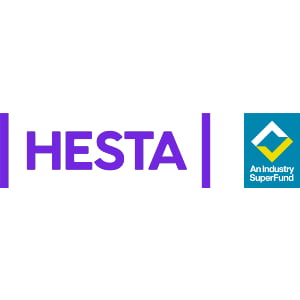
H. E. S. T. Australia Ltd
Portfolio level
Portfolio level – Portfolio decarbonisation reference target
Baseline: 30 June 2020
Target Year(s): 2030, 2050
Target(s): 2030: 50% reduction in tCO2e/AU$M invested
2050: Net zero carbon emissions
Baseline performance: 53 tCO2e/AU$M invested
GHG scopes included: Scope 1 and 2 normalised emissions are measured and included in portfolio emissions for investments that sit within asset classes that make up the largest proportion of assets under management and for which data and appropriate methodologies exist.
Asset classes in scope: Listed equities, infrastructure, property, private equity, and the global credit and alternative credit components of global debt.
Methodology: HESTA’s attributed scope 1 and 2 emissions (based on enterprise value) for listed equities are calculated as per the Partnership for Carbon Accounting Financials (PCAF) methodology and are subject to independent assurance. Data is based on portfolio holdings as at each financial year end (30 June) and is sourced from MSCI BarraOne software which reports company reported emission numbers and MSCI modelled emissions where needed. We seek to collect scope 3 data, but complete data is not available. We will look to improve data capture and reporting over time.
Portfolio level – Investment in climate solutions target
Quantitative target
Baseline date: 31 December 2021
Baseline performance: more than 5% of portfolio
Target year: 2030
Target: 10% of portfolio
Methodology: We measure progress towards our 2030 climate solutions target through annual measurement of investments aligned to SDG 7, 11.1 and 13, such as renewable energy and sustainable property, according to the Sustainable Development Investment Asset Owner Platform (SDI AOP) Taxonomy.
Asset level
Asset level – Portfolio coverage target
Approach: HESTA plans to undertake a baselining assessment of asset alignment according to the Framework and set targets in due course.
Asset level – Engagement threshold target
Approach: HESTA conducts company engagement through direct engagement, collaborative engagement and through service providers and external investment managers.
Approximately half of HESTA’s total scope 1 and 2 financed emissions (80% concentrated to 15 ASX-listed companies) are subject to direct engagement given their contribution to portfolio emissions. Remaining material emitters are engaged through collaborative engagement initiatives such as Climate Action 100+, specialist service providers and external investment managers. By combining these different approaches to engagement, we can achieve both breadth in terms of the number of companies covered by our engagement program as well as depth by focussing our direct engagement on those issues or holdings that are most material.
We engage with external Investment Managers on their approaches to reducing portfolio emissions. Using data and analysis from Climate Action 100+ and the Transition Pathway Initiative, we provide managers with our bespoke analysis of their portfolios and assess them against the three areas of risk management, opportunity, and engagement. This enables us to develop ongoing engagement priorities to progress our climate change transition plan.
Additional information
Methodology: HESTA has set portfolio carbon reduction targets to manage key financial and reputational climate-related risks. The targets seek to align the investment portfolio towards the aim of the Paris Agreement to limit global warming to well below 2°C above pre-industrial levels and pursue efforts to limit the temperature increase to 1.5°C, which requires economic transition to ’net zero emissions by 2050’.
Disclosure: HESTA’s Climate Change Report gives regard to the recommendations of the TCFD and provides an update on the implementation of its Climate Change Transition Plan of which portfolio targets are a key component.
The report provides information about HESTA’s approach to managing climate-related risks, as well as progress against the targets, portfolio integration and capital allocation, active ownership, and advocacy. The report is available at hesta.com.au/climate-action
Scenario(s) used: Using the REMIND model, we incorporate climate change considerations into our annual review of HESTA’s investment options to assess the impact from rising temperatures (across, 2o, 3o and 4o) on 5-year and 10-year returns. We have also used the NGFS scenarios to assess the potential macroeconomic impacts under various climate change scenarios.
In FY2023, HESTA conducted its second assessment of the physical risks of climate change to real assets held in the portfolio. Using a ‘high emissions, extreme physical damages’ scenario, we identified flooding, bushfire, water scarcity and hurricane as risks to real assets in HESTA’s investment portfolio. Testing the portfolio in this way enables HESTA to identify hot spots which can then be the focus of adaptation and resilience planning.
Fossil fuel policy: HESTA has a portfolio-wide exclusion, effective of 30 Sep 2022, on:
- Any listed company that derives 15% or more revenue from the mining of thermal coal.
- Any unlisted company that derives 15% or more revenue from mining or transportation of thermal coal.
Any company that derives both:
- 75% or more revenue from the extraction, production and refining of unconventional oil and gas; and
- 75% or more of its reserves from unconventional oil and gas.
Unconventional oil and gas includes tar sands, shale oil and gas and coal seam gas.
Operational emissions: HESTA’s operations are carbon neutral.
Further information can be found here.
H. E. S. T. Australia Ltd case studies